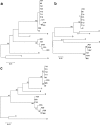Intestinal parasitic infections and associated factors in children of three rural schools in Colombia. A cross-sectional study
- PMID: 31291262
- PMCID: PMC6619675
- DOI: 10.1371/journal.pone.0218681
Intestinal parasitic infections and associated factors in children of three rural schools in Colombia. A cross-sectional study
Abstract
Rural children are one of the populations that are most vulnerable to gastrointestinal parasite infections. Such diseases decrease the quality of life and result in growth and cognitive delays in the long term. This cross-sectional study was conducted to determine the frequency of intestinal parasite infections among rural schoolchildren in the municipality of Apulo, Colombia. A total of 97 stool samples from children aged between 5 and 15 years were collected and examined via direct light microscopy. Microscopic examination was repeated with sediments obtained using a fecal parasite concentrator, and the Kato-Katz test was performed. Frequency of intestinal parasite infection was 100%. Endolimax nana (77.35%), Blastocystis sp. (71.1%), Giardia intestinalis (39.1%), Entamoeba coli (25.7%), and the Entamoeba histolytica/dispar/moshkovskii complex (9.2%) were the most prevalent protozoa. Trichuris trichiura was the most prevalent helminth (12.3%), followed by Enterobius vermicularis (6.15%) and Ascaris lumbricoides (5.1%). Among the analyzed associated factors, consumption of untreated water increased the risk of acquiring pathogenic intestinal parasites. Finally, because G. intestinalis was the most prevalent pathogenic protozoan, molecular analysis was conducted to establish genetic assemblages and subassemblages of Giardia through sequence-based genotyping of the glutamate dehydrogenase, triose phosphate isomerase, and beta-giardin genes. A total of 14 G. intestinalis-positive samples were genotyped, which revealed the presence of subassemblages AI (n = 1), AII (n = 7), BIII (n = 2), BIV (n = 2), and BIII/BIV (n = 1) as well as a mixed subassemblage AII + BIII (n = 1). Our results indicate that gastrointestinal parasite infections in the tested population were mainly caused by suboptimal water quality. Moreover, molecular typing of G. intestinalis suggested contamination of water by animal- and human-derived cysts.
Conflict of interest statement
The authors have declared that no competing interests exist.
Figures

Similar articles
-
Prevalence of intestinal parasites, with emphasis on the molecular epidemiology of Giardia duodenalis and Blastocystis sp., in the Paranaguá Bay, Brazil: a community survey.Parasit Vectors. 2018 Aug 30;11(1):490. doi: 10.1186/s13071-018-3054-7. Parasit Vectors. 2018. PMID: 30165880 Free PMC article.
-
Prevalence of intestinal parasitic infections and associated risk factors among schoolchildren in the Plateau Central and Centre-Ouest regions of Burkina Faso.Parasit Vectors. 2016 Oct 18;9(1):554. doi: 10.1186/s13071-016-1835-4. Parasit Vectors. 2016. PMID: 27756339 Free PMC article.
-
Intestinal parasite infections in a rural community of Rio de Janeiro (Brazil): Prevalence and genetic diversity of Blastocystis subtypes.PLoS One. 2018 Mar 9;13(3):e0193860. doi: 10.1371/journal.pone.0193860. eCollection 2018. PLoS One. 2018. PMID: 29522552 Free PMC article.
-
Giardia spp., the most ubiquitous protozoan parasite in Argentina: human, animal and environmental surveys reported in the last 40 years.Parasitol Res. 2020 Oct;119(10):3181-3201. doi: 10.1007/s00436-020-06853-7. Epub 2020 Aug 15. Parasitol Res. 2020. PMID: 32803334 Review.
-
Intestinal Parasitic Infection and Nutritional Status in Children under Five Years Old: A Systematic Review.Trop Med Infect Dis. 2022 Nov 12;7(11):371. doi: 10.3390/tropicalmed7110371. Trop Med Infect Dis. 2022. PMID: 36422922 Free PMC article. Review.
Cited by
-
Burden and Epidemiology of Human Intestinal Giardia duodenalis Infection in Colombia: A Systematic Review.Trop Med Infect Dis. 2022 Oct 21;7(10):325. doi: 10.3390/tropicalmed7100325. Trop Med Infect Dis. 2022. PMID: 36288066 Free PMC article. Review.
-
High Prevalence of Intestinal Pathogens in Indigenous in Colombia.J Clin Med. 2020 Aug 28;9(9):2786. doi: 10.3390/jcm9092786. J Clin Med. 2020. PMID: 32872252 Free PMC article.
-
Detangling the Crosstalk Between Ascaris, Trichuris and Gut Microbiota: What´s Next?Front Cell Infect Microbiol. 2022 May 25;12:852900. doi: 10.3389/fcimb.2022.852900. eCollection 2022. Front Cell Infect Microbiol. 2022. PMID: 35694539 Free PMC article. Review.
-
Molecular characterization and risk analysis of Giardia duodenalis assemblages in corticosteroid-treated and non-treated patients in Ismailia, Arab Republic of Egypt.Gut Pathog. 2024 Dec 13;16(1):74. doi: 10.1186/s13099-024-00668-y. Gut Pathog. 2024. PMID: 39673061 Free PMC article.
-
Water, sanitation, and hygiene conditions and prevalence of intestinal parasitosis among primary school children in Dessie City, Ethiopia.PLoS One. 2021 Feb 3;16(2):e0245463. doi: 10.1371/journal.pone.0245463. eCollection 2021. PLoS One. 2021. PMID: 33534792 Free PMC article.
References
-
- PAHO. Pan American Health Organization. Epidemiological profiles of neglected diseases and other infections related to poverty in Latin America and the Caribbean. 2009. Available from: https://www.paho.org/per/index.php?option=com_docman&view=download&alias.... Cited 19 November 2018.
-
- WHO. Integrating neglected tropical diseases into global health and development: fourth WHO report on neglected tropical diseases. Geneva: World Health Organization; 2017. Licence: CC BY-NC-SA 3.0 IGO.
Publication types
MeSH terms
Substances
LinkOut - more resources
Full Text Sources
Medical

